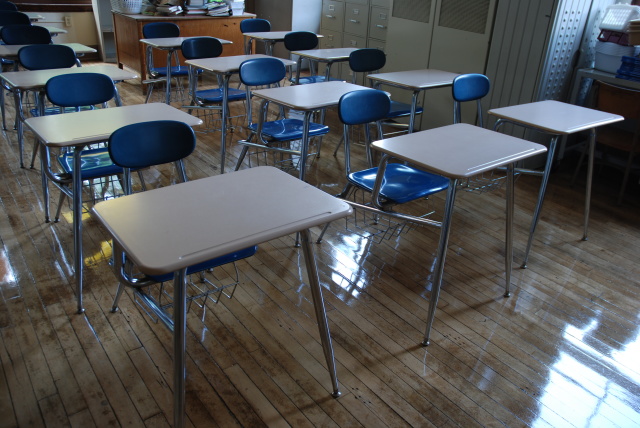On the eve of the No Child Left Behind Act of 2001, the John Marshall High School I taught at had an attendance rate of 80 percent. We knew we had a serious problem; students can’t learn if they are not in class. So, we made a major effort to address absenteeism, but it was simply impossible for our overburdened staff to make the systematic extra efforts necessary to get truancy under control.
Our problems grew much worse, however, when NCLB mandated that we dramatically raise attendance rates or face repercussions. As data-driven reformers should have known, high-challenge schools had to choose between a focus on the complex challenge of getting more students to come to school more often or the more doable task of just “juking the stats” and making sure absences disappeared from the district’s computer system.
Let me quickly get the following issue out of the way: The OKCPS responded to this maddeningly complicated dilemma like virtually every urban school system. While the district deserves criticism for playing statistical games to comply with test-driven reform, it didn’t create the output-driven policies that took low-performing inner-city schools and made them worse.
As a result, who knows how much of the subsequent reductions of absenteeism rates were real, and how much were the result of statistical games?
NCLB overlooked chronic absenteeism
The data below on chronic absenteeism was generated by the U.S. Office of Civil Rights. At present, it is available only on a disk that the OCR will mail to interested persons. (Local data on absenteeism is available on the OKCPS website.)
The OKCPS did a fairly good job of implementing the now-discredited game plan that was imposed on us. By the 2013-2014 school year, JMHS received a F on its report card, but its attendance rate was up to 91.4 percent. The old John Marshall had plenty of problems, but we were improving faster than any OKCPS high school.
Other OKCPS high schools:
U.S. Grant High School had an absenteeism rate of 89 percent and, for what it’s worth, earned a B on its report card, while Capitol Hill High School had an absenteeism rate of 88 percent and a C on its report card. Grant had 741 students (40 percent) who were chronically absent, and the majority of Capitol Hill students were chronically absent.
It was test-driven, competition-driven reform, not individual educators, that turned my Centennial (which served kids from the eastern half of the old JMHS feeder area) into the lowest performing school in the state.
By 2013-2014, the F-graded Centennial’s attendance rate was also about 91 percent, but, as the Johns Hopkins Everyone Graduates Center explained, the real issue was the number and percentage of students who were chronically absent. That year, 122 of the 344 Centennial high school students (or about one-third of them) were chronically absent.
At this point, some readers may be tempted to resurrect the blame game and claim that we should hold the secondary school and its students accountable for remediating the gaps in learning that emerged during elementary school — and before. The same pattern recurs throughout the nation, however.
When one-sixth of the elementary feeder school students are chronically absent and teams of caring adults don’t join the battle, it is likely that the rate will double by high school.
Replace accountability with responsibility
Today, we can continue the competition-driven blame game, or we can look to the 25 by 25 early education initiative and high-quality pre-kindergarten programs for guidance. We could replace data-driven accountability with a data-informed sense of responsibility. We could invest in early warning systems that immediately identify truancy problems in early elementary schools. We could assemble teams of counselors, attendance officers and volunteers who use timely attendance data and actually make the number of home visits required to address structural barriers to attendance.
Or, we can continue to use metrics as ammunition to fuel the edu-politics of destruction.
I won’t drag the latest battle over KIPP and charter expansion into this analysis, except to point out the magnitude of the problems faced by near-eastside neighborhood schools and suggest a win-win solution.
The four elementary schools that are closest to KIPP are Moon, Martin Luther King, Edwards and Thelma Parks. They had a total of 1,595 students, and about 17 percent of them were chronically absent. What if we had put our anger about educational problems on hold and wrapped our arms around the 263 children who regularly have not attended class. What if we helped prevent so many of them from falling dramatically behind in terms of classroom instruction?
Based on numerous background conversations with OKCPS administrators, I learned that many of them were aware of the huge body of social science that explains why my Centennial High School could not be improved by using the standard NCLB-era solutions: better curriculum, High Expectations, holding teachers and administrators accountable for better instruction and accepting No Excuses. My sense is that business and community members also understood that Centennial was the classic example of a school that required “wraparound services,” a team of mentors and an early warning system for the team effort required to reduce chronic absenteeism.
Ample opportunity to mimic the success of others
Back then, those humane, science-driven policies simply were off the table. Then, the Obama administration put NCLB-type reform on steroids. It funded and basically mandated the entire test-sort-reward-and-punish agenda that became known as “corporate school reform.” It gave lip service to Johns Hopkins’ Everyone Graduates Center and its research that explained why teachers alone can’t address the structural barriers to attending class. It is now clear that the high-poverty neighborhood schools we have in Oklahoma won’t improve very much until we fund and staff the early warning systems that Johns Hopkins developed.
So, if we want to help kids, we should consider last week’s Washington Post account of the improvement started by early warning systems and the progress that occurs “when schools focus on reducing absenteeism and course failure” as opposed to “cramming for an annual test.”
But the highest-poverty schools must then adopt the Hopkins Diplomas Now approach, which “brings people into schools, not just ideas and strategies.” Hopkins researcher Robert Balfanz said, “There are too many needy kids and not enough adults. Until you change that equation, it doesn’t matter if you give them new strategies.”
Washington, D.C.’s Diplomas Now draws on numerous partners, such as the AmeriCorps program, counselors and volunteer mentors. Oklahoma City’s schools are much more challenging than those in D.C., but does anyone doubt that we could contribute just as many professionals and volunteers to the civil rights movement of the 21st century?























